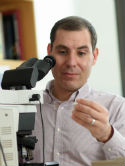Infectivity and shedding of mouse kidney parvovirus after oronasal inoculation of C57BL/6, CD1, and NSG mice Journal Article
| Authors: | Kain, M. L.; Ricart Arbona, R. J.; Henderson, K. S.; Dhawan, R.; Monette, S.; Lipman, N. S. |
| Article Title: | Infectivity and shedding of mouse kidney parvovirus after oronasal inoculation of C57BL/6, CD1, and NSG mice |
| Abstract: | Mouse kidney parvovirus (MKPV), the etiology of murine inclusion body nephropathy, has been identified globally in mice used for research, with an estimated prevalence of 10% in academic colonies. In immunodeficient strains, MKPV causes significant morbidity and mortality, and severe renal pathology. In contrast, in immunocompetent mice, the infection is subclinical and causes minimal pathology. We investigated viral infectivity and shedding in inbred C57BL/6NCrl (B6), outbred Crl:CD1(ICR) (CD1), and highly immunocompromised NOD.Cg-PrkdcscidIl2rgtm1Wjl/SzJ (NSG) mice. Four doses, ranging from 1.16 × 103 to 1.16 × 106 viral copies per microliter, of an MKPV inoculum were administered oronasally to 3 mice per dose per mouse type. All 3 types (B6, CD1, and NSG) had persistent infection with prolonged shedding in urine and feces. Viral copy number in the urine generally increased over time, while shedding in the feces was more variable. Among the 3 populations, CD1 mice developed viral shedding in urine earliest (4 wk after inoculation) and at higher levels (greater than 1 × 107 viral copies per microliter). B6 mice become viruric later (7 wk after inoculation), with lesser virus shed (1 × 106 viral copies per microliter or less). In CD1 and B6 mice, peak urine shedding occurred at 11 to 14 wk after inoculation, after which levels gradually declined until 35 wk after inoculation (study endpoint). In contrast, NSG mice did not become viruric until 10 wk after inoculation and continued to shed large amounts of virus (greater than 1 × 107 viral copies per microliter) in urine until the study endpoint. Two commercial immunofluorescent serologic assays failed to detect serum antibodies to MKPV nonstructural protein 1 as late as 58 wk after inoculation, whereas immunohistochemistry of infected renal tissue successfully detected anti-MKPV serum antibodies. These results increase our knowledge of the biology of MKPV and have practical application for development of effective screening programs for this pathogen. © 2022 by the American Association for Laboratory Animal Science. |
| Keywords: | controlled study; nonhuman; mouse; animal; animals; mice; kidney disease; animal experiment; institute for cancer research mouse; mice, inbred icr; mice, scid; mice, inbred c57bl; c57bl mouse; kidney; veterinary medicine; c57bl 6 mouse; mice, inbred nod; nonobese diabetic mouse; scid mouse; nonstructural protein 1; virus infectivity; virus antibody; antibody blood level; virus shedding; parvovirus; minute virus of mice; female; article; parvoviridae; nod scid gamma mouse; cd-1 mouse; inclusion body nephropathy; virus inclusion; parvoviridae infections; ibn; mkpv; mouse kidney parvovirus; mouse parvovirus; mpv; mucpv; murine chapparvovirus; mvm; parvovirus infection |
| Journal Title: | Comparative Medicine |
| Volume: | 72 |
| Issue: | 6 |
| ISSN: | 1532-0820 |
| Publisher: | American Association for Laboratory Animal Science |
| Date Published: | 2022-12-01 |
| Start Page: | 376 |
| End Page: | 385 |
| Language: | English |
| DOI: | 10.30802/aalas-cm-22-000066 |
| PUBMED: | 36744512 |
| PROVIDER: | scopus |
| PMCID: | PMC9827609 |
| DOI/URL: | |
| Notes: | The MSK Cancer Center Support Grant (P30 CA008748) is acknowledged in the PDF.. Corresponding author is MSK author Neil S Lipman -- Export Date: 1 March 2023 -- Source: Scopus |
Altmetric
Citation Impact
BMJ Impact Analytics
MSK Authors
Related MSK Work







